牛客周赛84
续上周
D
赛时用的数学方法,花的时间和代码量比较多。差分我写得少,这里用题解的差分方法补个题
用差分数组对每个k区间做修改,然后求和以及相邻数字绝对值差对陡峭值的贡献即可
1
2
3
4
5
6
7
8
9
10
11
12
13
14
15
16
17
18
19
20
21
22
23
24
| #include <bits/stdc++.h>
using namespace std;
const int maxn = 1e6+1;
int t[maxn],d[maxn];
int main(void){
ios::sync_with_stdio(false);
cin.tie(0);cout.tie(0);
int n,k,ans=0;
cin >> n >> k;
string s;
cin >> s;
for(int i=1,j=k;j<=n;i++,j++){
d[i]++;
d[j]--;
}
t[0]=0;
for(int i=1;i<=n;i++){
t[i] += t[i-1] + d[i];
ans += t[i] * abs(s[i]-s[i-1]);
}
cout << ans << '\n';
return 0;
}
|
E
题目
以1为根节点,用dfs搜出每个子树的陡峭值,然后再用dfs求出每个节点与其子树断开后的陡峭值之差的绝对值,ans取最小
1
2
3
4
5
6
7
8
9
10
11
12
13
14
15
16
17
18
19
20
21
22
23
24
25
26
27
28
29
30
31
32
33
34
35
36
37
38
39
40
| #include <bits/stdc++.h>
#define int long long
using namespace std;
const int maxn = 1e5+1;
vector <int> G[maxn];
int sum[maxn]={0},ans = 2LL<<60;
void dfs_sum(int u,int f){
for(auto &v:G[u]){
if(v == f)
continue;
dfs_sum(v,u);
sum[u] += sum[v] + abs(u-v);
}
}
void dfs_split(int u,int f){
for(auto &v:G[u]){
if(v == f)
continue;
ans = min(ans,abs(sum[v]-(sum[1]-sum[v]-abs(u-v))));
dfs_split(v,u);
}
}
signed main(void){
ios::sync_with_stdio(false);
cin.tie(0);cout.tie(0);
int n,u,v;
cin >> n;
for(int i=0;i<n-1;i++){
cin >> u >> v;
G[u].push_back(v);
G[v].push_back(u);
}
dfs_sum(1,0);
dfs_split(1,0);
cout << ans << '\n';
return 0;
}
|
CF1006 div.3
A
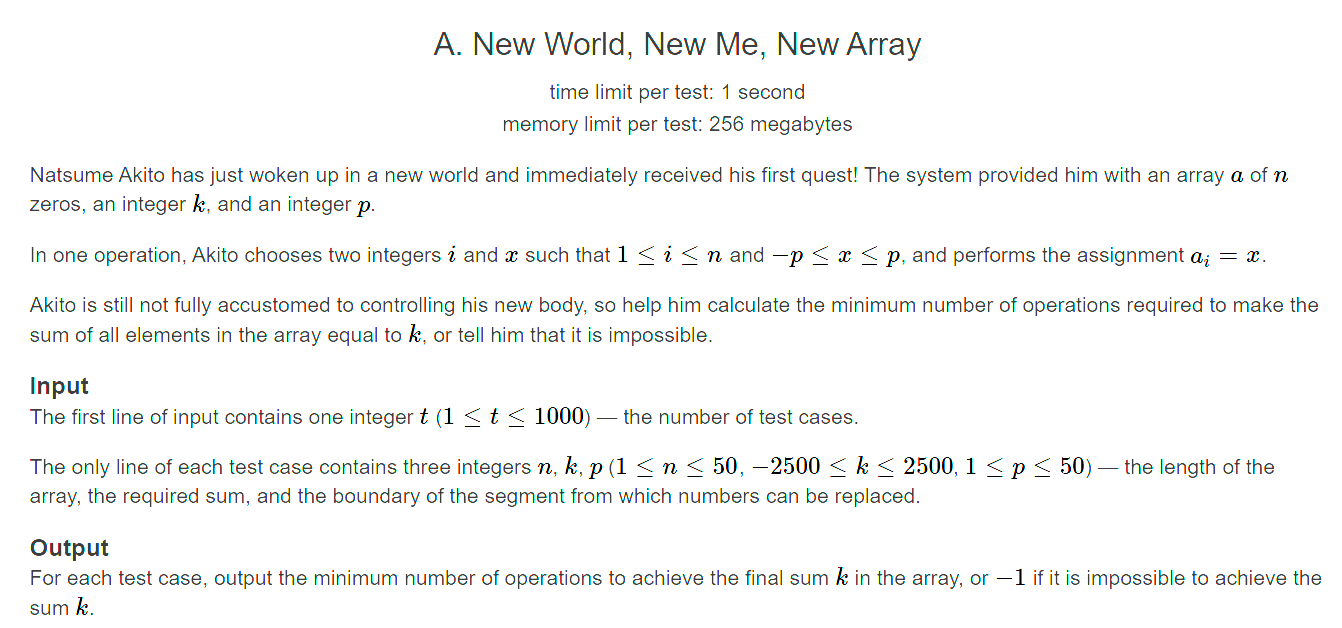
求最少操作次数,贪心,如果n*p < |k|了,肯定不行,否则就是k/p
1
2
3
4
5
6
7
8
9
10
11
12
13
14
15
16
17
18
| #include <bits/stdc++.h>
using namespace std;
int main(void){
ios::sync_with_stdio(false);
cin.tie(0);cout.tie(0);
int t;
cin >> t;
while(t--){
int n,k,p;
cin >> n >> k >> p;
if(n*p < abs(k)){
cout << "-1\n";
}
else cout << ceil(1.0*abs(k)/p) << '\n';
}
return 0;
}
|
B
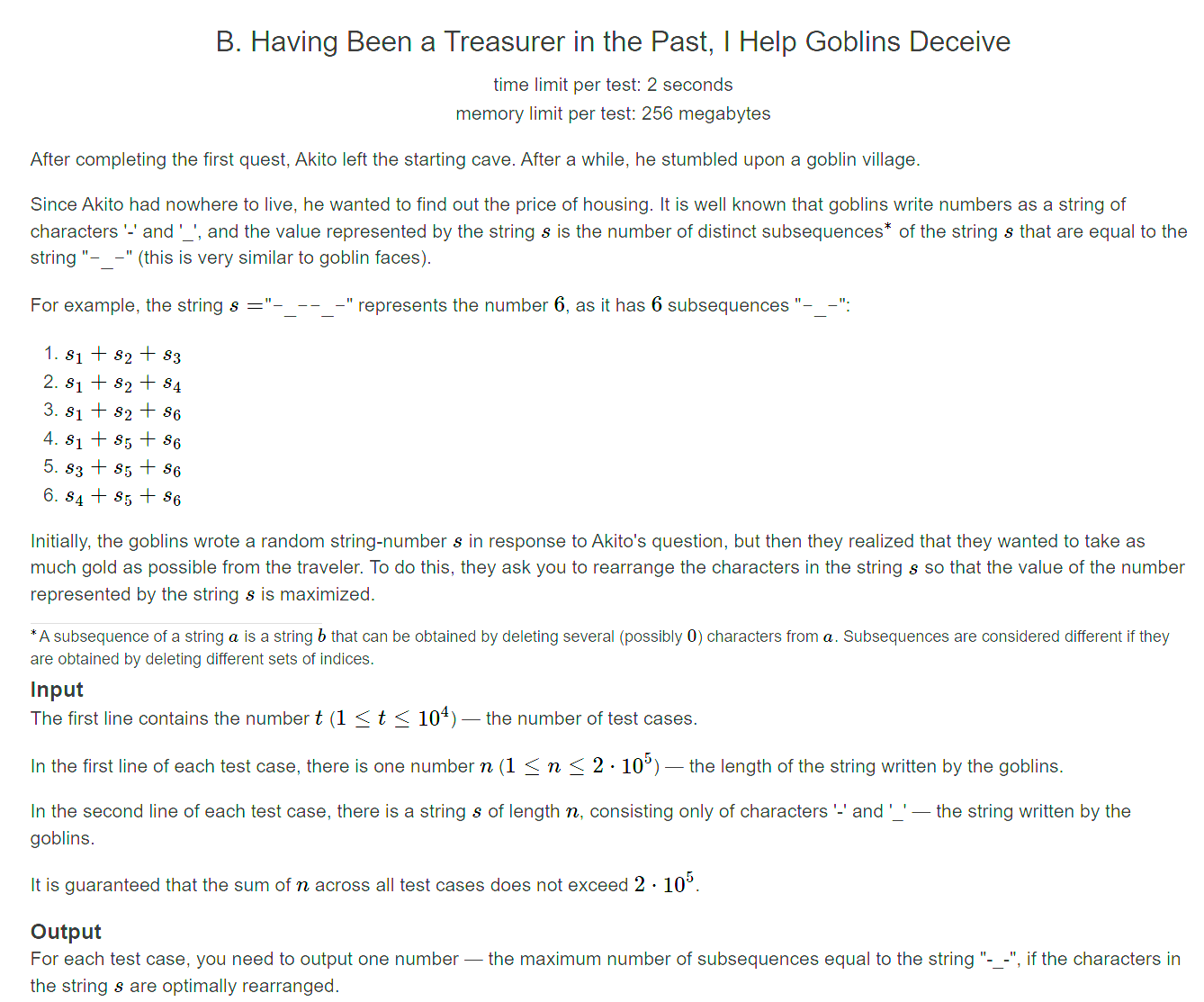
可以发现,数量最多的情况就是"--“尽可能呈对称的情况,”"全都放在中间。
特判就是n<3的时候无法组成图案
1
2
3
4
5
6
7
8
9
10
11
12
13
14
15
16
17
18
19
20
21
22
23
24
25
26
| #include <bits/stdc++.h>
#define int long long
using namespace std;
signed main(void){
ios::sync_with_stdio(false);
cin.tie(0);cout.tie(0);
int t;
cin >> t;
while(t--){
int n; string s;
cin >> n >> s;
if(n < 3){
cout << "0\n";
continue;
}
int num1 = 0,num2 = 0,si = s.size();
for(int i=0;i<si;i++){
if(s[i] == '-') num1++;
else num2++;
}
int a1 = num1/2, a2 = num1-a1;
cout << a1*num2*a2 << '\n';
}
return 0;
}
|
C
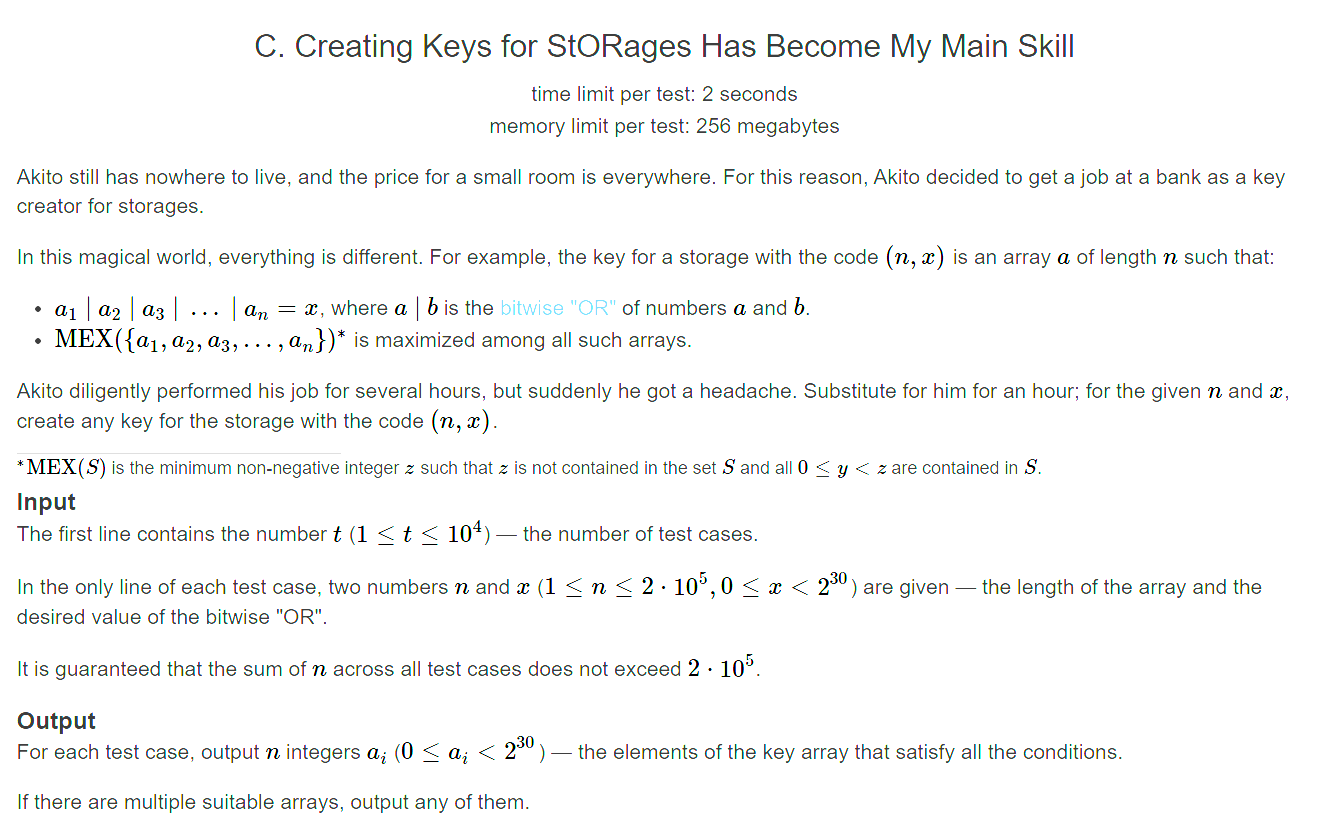
贪心,用num来模拟每个数按位或
因为按位或不会增加二进制位数,所以当第n个数或后都还小于x的话,直接输出x;中间某个数或x后大于x了(即x的二进制的某位是0),那么从这个数以后都输出x
1
2
3
4
5
6
7
8
9
10
11
12
13
14
15
16
17
18
19
20
21
22
23
24
25
26
27
28
29
| #include <bits/stdc++.h>
using namespace std;
int main(void){
ios::sync_with_stdio(false);
cin.tie(0);cout.tie(0);
int t;
cin >> t;
while(t--){
int n,x;
cin >> n >> x;
int num=0;
for(int i=0;i<n;i++){
num |= i;
if((num | x) > x){
for(;i<n;i++)
cout << x << ' ';
break;
}
if(i == n-1 && num < x){
cout << x << ' ';
break;
}
cout << i << ' ';
}
cout << '\n';
}
return 0;
}
|
D
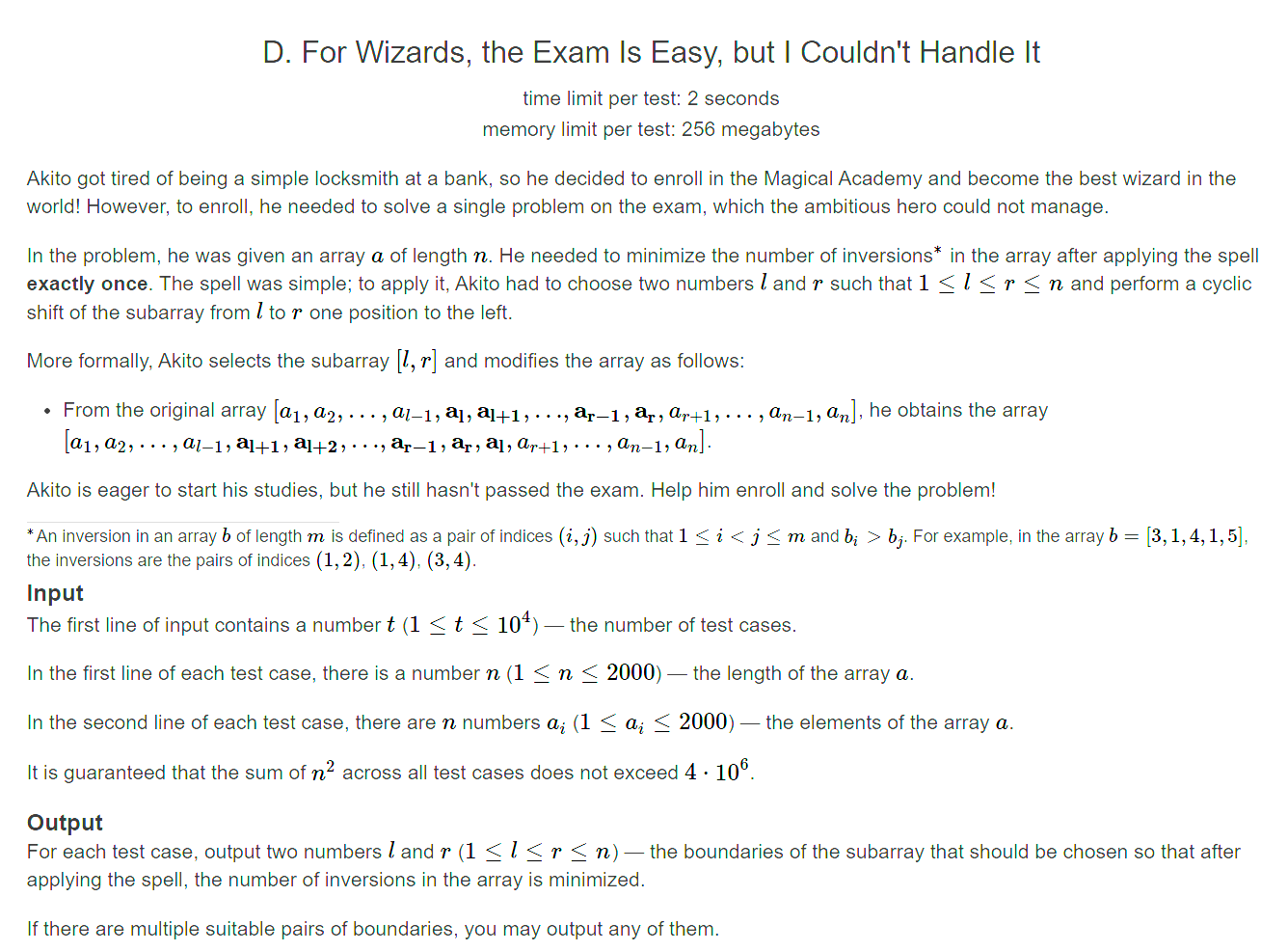
贪心地想,要使得交换后逆序对尽可能少,那么就要让区间(l,r)上比al大的尽可能少,比al小的尽可能多。用da记录比al大的,xiao记录比al小的,xiao-da的值越大,就说明l和r交换后逆序对越少
这个算法是O(n2)的复杂度,题目给的数据范围内是可接受的
1
2
3
4
5
6
7
8
9
10
11
12
13
14
15
16
17
18
19
20
21
22
23
24
25
26
27
28
29
30
31
32
33
| #include <bits/stdc++.h>
using namespace std;
vector <int> a(2001);
int main(void){
ios::sync_with_stdio(false);
cin.tie(0);cout.tie(0);
int t;
cin >> t;
while(t--){
int n;
cin >> n;
a.clear();
for(int i=1;i<=n;i++)
cin >> a[i];
int ans=0,l=1,r=1;
for(int i=1;i<=n;i++){
int da=0, xiao=0;
for(int j=i;j<=n;j++){
if(a[j] > a[i])
da++;
else if(a[j] < a[i])
xiao++;
if(ans < xiao - da){
ans = xiao - da;
l=i,r=j;
}
}
}
cout << l << ' ' << r << '\n';
}
return 0;
}
|
状压DP
状压DP是DP的一种优化方法
Hamilton旅行商问题
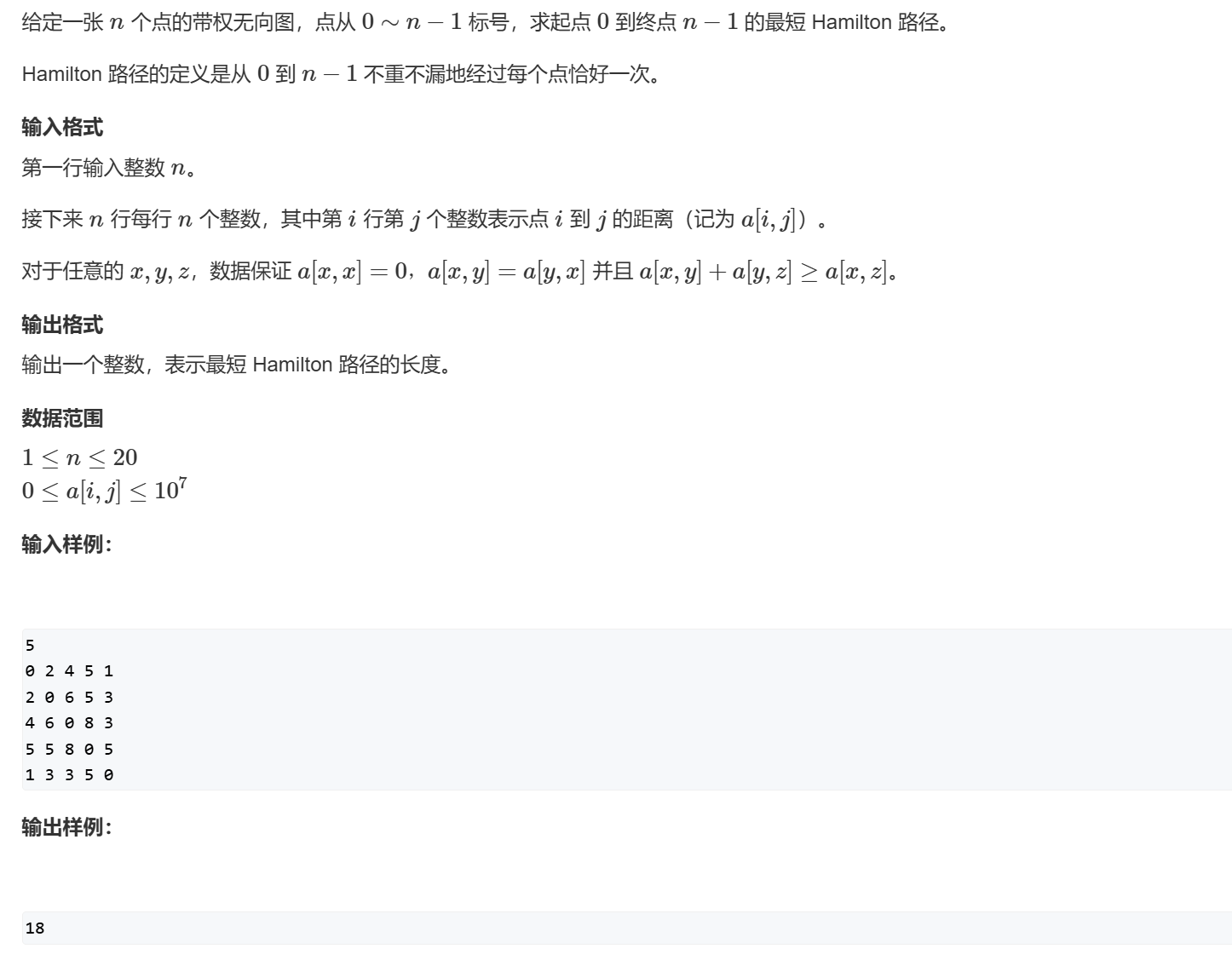
Hamilton问题是NP问题,没有多项式复杂度的解法,暴力解法复杂度是O(n*n!),而状压DP可将复杂度将为O(n2*2n)
设S是图的一个子集;
dp[S][j]:表示“集合S内的最短Hamilton路径”,即从起点0出发经过S中所有点,到达终点j时的最短路径;集合S中包括j点;
让S从最小的子集逐步拓展到整个图,最后得到的dp[N][n-1]就是答案,N表示包含图上所有点的集合。
(S-j表示从集合S中去掉j,即不包含j点的集合)
设k为S-j中一个点,把从0到j的路径分为两部分:(0->…->k)+(k->j)。以k为变量枚举S-j中所有的点,找出最短路径
状态转移方程为:
dp[S][j] = min(dp[S-j][k] + dist(k,j))
状态压缩DP的技巧:用一个二进制数表示集合S,即把S压缩到一个二进制数中,S的每一位表示图上的一个点,0表示不包含,1表示包含
例如S = 0000 0101,表示包含2,0这两个点
if((S>>j) & 1),判断当前的集合S中是否含有j点
if((S^(1<<j))>>k & 1) ,其中S^(1<<j)的作用是从集合中去掉j点,得到集合S-j,然后>> k & 1表示用k遍历集合中的1,这些1就是S-j中的点,这样就实现了"枚举集合S-j中所有的点" (S^(1<<j))也可以写成S-(1<<j)
Code
1
2
3
4
5
6
7
8
9
10
11
12
13
14
15
16
17
18
19
20
21
22
23
| #include <bits/stdc++.h>
using namespace std;
int n,dp[1<<20][21];
int dist[21][21];
int main(void){
ios::sync_with_stdio(false);
cin.tie(0);cout.tie(0);
memset(dp,0x3f,sizeof(dp));
cin >> n;
for(int i=0;i<n;i++)
for(int j=0;j<n;j++)
cin >> dist[i][j];
dp[1][0] = 0;
for(int S=1;S<(1<<n);S++)
for(int j=0;j<n;j++)
if((S>>j) & 1)
for(int k=0;k<n;k++)
if((S^(1<<j)) >> k & 1)
dp[S][j] = min(dp[S][j],dp[S^(1<<j)][k] + dist[k][j]);
cout << dp[(1<<n)-1][n-1] << '\n';
return 0;
}
|











